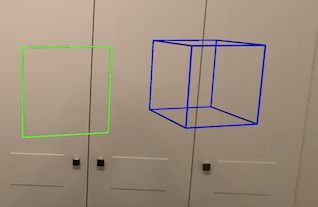Draw straight line

Description
As you've seen in the Shapes lesson, we can add a number of built in geometry shapes to our scene.
But how do you draw a straight line in ARKit?
If you check out the code sample below, you will be able to see that we can use a long thin cylindar to draw a straight line between two points.
Video
Code
using ARKit;
using SceneKit;
using UIKit;
using System;
namespace XamarinArkitSample
{
public partial class StraightLineViewController : UIViewController, IARSCNViewDelegate
{
private readonly ARSCNView sceneView;
private static readonly float lineRadius = 0.001f;
private static readonly int radialSegments = 10;
public StraightLineViewController()
{
this.sceneView = new ARSCNView
{
AutoenablesDefaultLighting = true,
Delegate = this
};
this.View.AddSubview(this.sceneView);
}
public override void ViewDidLoad()
{
base.ViewDidLoad();
this.sceneView.Frame = this.View.Frame;
}
public override void ViewDidAppear(bool animated)
{
base.ViewDidAppear(animated);
this.sceneView.Session.Run(new ARWorldTrackingConfiguration
{
AutoFocusEnabled = true,
LightEstimationEnabled = true,
WorldAlignment = ARWorldAlignment.Gravity,
}, ARSessionRunOptions.ResetTracking | ARSessionRunOptions.RemoveExistingAnchors); ;
// Draw straight line
DrawLineNode(new SCNVector3(0, 0, 0), new SCNVector3(0.1f, 0, 0), UIColor.Red);
// Draw square with lines
DrawLineNode(new SCNVector3(0.2f, 0, 0), new SCNVector3(0.3f, 0, 0), UIColor.Green); // Bottom line
DrawLineNode(new SCNVector3(0.3f, 0, 0), new SCNVector3(0.3f, 0.1f, 0), UIColor.Green); // Right line
DrawLineNode(new SCNVector3(0.2f, 0.1f, 0), new SCNVector3(0.3f, 0.1f, 0), UIColor.Green); // Top line
DrawLineNode(new SCNVector3(0.2f, 0, 0), new SCNVector3(0.2f, 0.1f, 0), UIColor.Green); // Left line
// Draw cube with lines
// Front Square
DrawLineNode(new SCNVector3(0.4f, 0, 0), new SCNVector3(0.5f, 0, 0), UIColor.Blue); // Bottom line
DrawLineNode(new SCNVector3(0.5f, 0, 0), new SCNVector3(0.5f, 0.1f, 0), UIColor.Blue); // Right line
DrawLineNode(new SCNVector3(0.4f, 0.1f, 0), new SCNVector3(0.5f, 0.1f, 0), UIColor.Blue); // Top line
DrawLineNode(new SCNVector3(0.4f, 0, 0), new SCNVector3(0.4f, 0.1f, 0), UIColor.Blue); // Left line
// Back Square
DrawLineNode(new SCNVector3(0.4f, 0, -0.1f), new SCNVector3(0.5f, 0, -0.1f), UIColor.Blue); // Bottom line
DrawLineNode(new SCNVector3(0.5f, 0, -0.1f), new SCNVector3(0.5f, 0.1f, -0.1f), UIColor.Blue); // Right line
DrawLineNode(new SCNVector3(0.4f, 0.1f, -0.1f), new SCNVector3(0.5f, 0.1f, -0.1f), UIColor.Blue); // Top line
DrawLineNode(new SCNVector3(0.4f, 0, -0.1f), new SCNVector3(0.4f, 0.1f, -0.1f), UIColor.Blue); // Left line
// Joining Front Square with Back Square
DrawLineNode(new SCNVector3(0.4f, 0, 0), new SCNVector3(0.4f, 0, -0.1f), UIColor.Blue);
DrawLineNode(new SCNVector3(0.5f, 0f, 0), new SCNVector3(0.5f, 0f, -0.1f), UIColor.Blue);
DrawLineNode(new SCNVector3(0.4f, 0.1f, 0), new SCNVector3(0.4f, 0.1f, -0.1f), UIColor.Blue);
DrawLineNode(new SCNVector3(0.5f, 0.1f, 0), new SCNVector3(0.5f, 0.1f, -0.1f), UIColor.Blue);
}
public void DrawLineNode(SCNVector3 pointA, SCNVector3 pointB, UIColor color)
{
var distance = DistanceBetweenPoints(pointA, pointB);
var line = DrawCylinderBetweenPoints(pointA, pointB, distance, lineRadius, radialSegments, color);
line.Look(pointB, sceneView.Scene.RootNode.WorldUp, line.WorldUp);
this.sceneView.Scene.RootNode.AddChildNode(line);
}
public static SCNNode DrawCylinderBetweenPoints(SCNVector3 a, SCNVector3 b, nfloat length, nfloat radius, int radialSegments, UIColor color)
{
var material = new SCNMaterial();
material.Diffuse.Contents = color;
SCNNode cylinderNode;
SCNCylinder cylinder = new SCNCylinder();
cylinder.Radius = radius;
cylinder.Height = length;
cylinder.RadialSegmentCount = radialSegments;
cylinderNode = SCNNode.FromGeometry(cylinder);
cylinderNode.Position = GetMidpoint(a, b);
cylinderNode.Geometry.FirstMaterial = material;
return cylinderNode;
}
public static nfloat DistanceBetweenPoints(SCNVector3 a, SCNVector3 b)
{
SCNVector3 vector = new SCNVector3(a.X - b.X, a.Y - b.Y, a.Z - b.Z);
return (nfloat)Math.Sqrt(vector.X * vector.X + vector.Y * vector.Y + vector.Z * vector.Z);
}
public static SCNVector3 GetMidpoint(SCNVector3 a, SCNVector3 b)
{
float x = (a.X + b.X) / 2;
float y = (a.Y + b.Y) / 2;
float z = (a.Z + b.Z) / 2;
return new SCNVector3(x, y, z);
}
public override void ViewDidDisappear(bool animated)
{
base.ViewDidDisappear(animated);
foreach (var node in this.sceneView.Scene.RootNode.ChildNodes)
{
node.RemoveFromParentNode();
}
this.sceneView.Session.Pause();
}
}
}
Next Step : Looking at gaze
After you have mastered this you should try Looking at gaze


